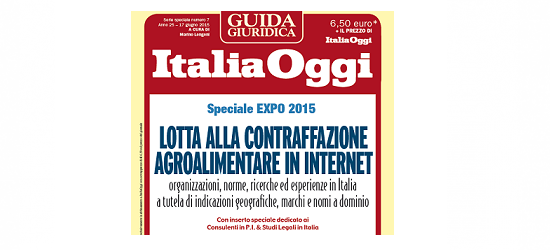
Luca Barbero, Trademark Attorney – Studio BARBERO, Turin
Covering the various aspects of wine and food industry related to designations of origin, brand protection, anti-competitive rules, counterfeiting is a very complex phenomenon that becomes even more complex in the on line environment. The web is indeed an international showcase for Italian food industry products, but it also represents a threat; most of the frauds related to food, detrimental especially to regional products including DOP and IGP, take place online.
In order to attempt to stop such infringements, the protection of trademarks, geographical indications and designations of origin online, along with the monitoring on domain names’ registrations confusingly similar to them and the enforcement of anti-counterfeiting measures online are activities of paramount importance.
As to the domain names are concerned, the introduction in 2012 by the Internet Corporation for Assigned Names and Numbers (ICANN) of the new generic Top Level Domains (TLD) – which currently counts more than 600 extensions – is certainly a particularly relevant development. Interesting examples for food industry are .bio and .organic, whose Registries required the applicants to be certified organic producers as well as .food, .cafe. There are also many other new TLDs which could be of interest for trademark owners within the food industry, such as .online, .store or .website that could be in fact considered – in light of the generic top level domain – for defensive purposes and/or for promoting an online business.
In addition to the traditional tools available to identify and challenge the abusive registrations of domain names, such as monitoring activities on domain name which are identical or confusingly similar to the distinctive signs, the Uniform Domain Name Dispute Resolution Policy (which has proved to be a very efficacious, rapid and cost-effective adr procedure) and the possible legal actions aimed at reclaiming infringing domain names, new tools to enforce the intellectual property rights within the new gTLDs were introduced. In particular, during the first period of the launch of each new TLD, each Registry is required to offer two services, a “Sunrise period” of at least 30 days in which trademark holders have an advance opportunity to register domain names corresponding to their marks before they are made available to the public, and the notification service during the so-called “Trademark Claims” period.
Both services are supported by the Trademark Clearinghouse (TMCH), a global repository for trademark data where, among others, individual and collective marks registered as National, European Union or International Trademark and signs protected by law or by treaty, including geographical designations and indications of origin, can be recorded. For example, the collective mark PARMIGIANO REGGIANO and the designations of origin BARBARESCO and BAROLO are recorded in the TMCH.
Once trademarks are submitted to the TMCH, right holders receive a unique authentication key (Signed Mark Data), which can be used to register domain names in the Sunrise phases. The Trademark Claims Service, on the other hand, consists in the notification by the TMCH to anyone attempting to register a domain name matching a TMCH recorded mark that such registration would likely infringe trademark rights and a subsequent notification to Trademark Holders, should the applicant proceed notwithstanding the notice received. Furthermore, in light of the increasing popularity among consumers and corporations of Social Media and Applications for smartphones and tablets, which are essential digital tools for the actual advertising and sale of products, it is imperative to closely monitoring also such media in order to swiftly evaluate possible enforcement activities but also to adopt the most suitable strategy to protect Intellectual Property Rights in such sensitive environment.
